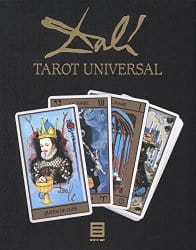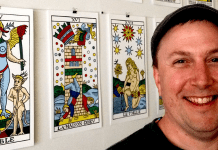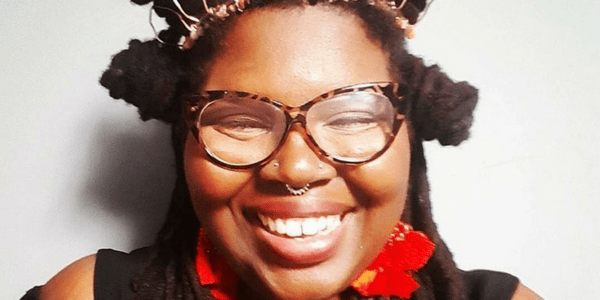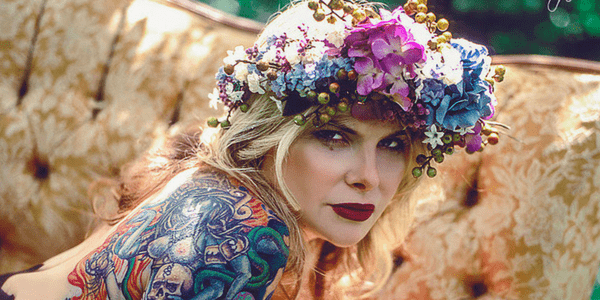
In the interest of full disclosure, Marjorie Jensen has written previously for Spiral Nature.
Psyche: How did Arcana: The Tarot Poetry Anthology come about?
Marjorie Jensen: I wanted to read as much tarot poetry as I could find, and there wasn’t a lot collected. There were solo collections, and I started reading some of those, and I wanted a starting point to find which solo collections I was most interested in. So, I talked to my graduate thesis director about wanting to do this project
So, you were looking for collections of tarot poetry in particular.
Yeah, I’d read some tarot prose and I’ve run workshops on tarot fiction as well as tarot poetry, but there hadn’t been tarot anthologies, where there are anthologies of tarot fiction.
What was it that got you interested in tarot poetry to begin with, was it TS Eliot’s The Waste Land, which seems to be a popular entry point, or was it something else?
The first one I wrote I was working with Truong Tran; he’s a wonderful poet. He was working at Mills College, and he’s a visual artist as well as a poet. He had this series in our graduate workshop class, the Art21 series that ran on PBS. They interviewed artists and talked about the techniques of visual artists, and he had to translate those visual art projects into writing, which was fascinating.
One of them was called Sounding the Tower, and I can’t remember the name of the artist. She built this tower, it had people singing, and there was a well at the bottom of the tower. I ended up writing a poem about the Tower tarot card in relation to that piece. That’s kind of where it began, and it took off from there.
In your forward you celebrate tarot as a muse. How does tarot become a muse, or muses work through tarot?
One poem was based on Dante’s use of three-line stanzas, each of the lines has the trinity inside it, and so I had three-line stanzas throughout, and [in place of the trinity] used the goddess, myself and another woman as subjects. I used a couple different cards for that.
I mostly write sonnets, and I started writing with tarot spreads and sonnets. Then I started my own major arcana series where it was one poem per card, and I’m almost done with these; I have half of a poem left.
I’ve been collecting decks throughout this process. In the beginning I had just three decks, and now I have 15 or 16 decks. I lay out all the cards from different decks, so it’s the same card, but all different decks. I look at them, compare and contrast the art, and find my way of making my own card, but in the form of a poem.
I’m really into the multiple card poems, and I’ve created this Shakespearean sonnet spread where I use four cards, and it’s like the three arguments and the conclusion you see in most Shakespearean sonnets.
From what you’re saying, it sounds like the inspiration goes both ways, the artwork inspires the poetry, and poetic form inspires how you incorporate the tarot.
 Yeah, I’m very visually-oriented, and I’m really into ekphrasis, and using art as inspiration. Before I got into the tarot, I was writing poems about paintings. I love that tradition, and I feel like tarot poetry really fits in well.
Yeah, I’m very visually-oriented, and I’m really into ekphrasis, and using art as inspiration. Before I got into the tarot, I was writing poems about paintings. I love that tradition, and I feel like tarot poetry really fits in well.
Art itself is transcendental in so many ways. For instance, the Salvador Dali Tarot, and the idea that artists interact with the archetypes and use this as a springboard. This is how I feel about formal poetry too: you have a form that exists and you have the tarot structure that exists, but you make it your own. That’s how I feel the muse aspects work. I have a framework, and I can build upon that. And break the framework if I don’t like it.
In your preface you mention the Two of Swords was the card that got you hooked on tarot. What was it about that particular card that attracted you, and which deck was it from?
I started with the Aquarian Tarot, which is very similar to the Rider-Waite-Smith.
which is very similar to the Rider-Waite-Smith.
The woman blindfolded with the crossed swords — that’s the image that’s always been the biggest thing for me; I feel like I really relate to her. She came up a lot when I first started learning tarot as a teenager. It would pop out the deck when I shuffled cards, it would show up in readings for myself and others.
I’m always trying to balance logic and emotion in my life. I feel like she’s very contemplative, in her own head, and not looking out.
The crossed swords are really important. That idea of a crossroads, when I’ve written about her I’ve talked about being at a literal crossroads on the ground, moving her away from the ocean to a difference place. Her being in a choice situation, at a literal crossroads has been the most important part of that card for me.
You’ve got a forward from Mary K. Greer, a poem from Rachel Pollack, how did you approach them, did they approach you? How did you end up with so many wonderful people in your book?
Everybody’s been so incredibly supportive. Some folks responded to the main calls for submissions that I put on Facebook groups and the UPenn call for submission site. Some of them I contacted individually.
I started with Enrique Enriquez, who put me in touch with a lot of other folks. He’s super into the tarot poetry world; he’s my guide in many ways, but he’s also very different in his style and his approach. I feel like we complement each other really well. He was the one who said, “You have to talk to Rachel, if you haven’t already,” Rachel was supposed to do the introduction, but unfortunately she got ill. She’s now on the mend I hear, and is recovering quite nicely from her treatments for cancer. So, I actually asked Mary K. Greer at the very last minute to step in. She did it for free, because our crowd-funding didn’t go very well. It was amazing that we were able to put out the book at all, in part because she waived her usual fee for doing introductions. She liked the book that much. That was amazing. I felt really upset about the whole crowd-funding thing, and then when she stepped up and said “This is such a wonderful thing and I want to support you.”

I recognize a lot of other names, Enrique Enriquez, which you already mentioned, and also James Wells, and of course Tabitha Dial who also writes for Spiral Nature, Camelia Elias, who we’ve reviewed before. It was great to see this collection, and they’re all so different in their approaches, whether writing about specific cards, specific decks, very personal poems, or poems talking about the imagery. What did your selection process look like?
 There were several hundred submissions, and I knew from the beginning that I wanted 78 poems, and [even then] I cheated. The poets themselves categorized them as separate poems, but we merged them into one poem in order to get more in the book. With their permission of course! I asked in advance if this was ok with them, if I could list them as collected poems rather than individual poems. Victor Coleman is one example where he released each of the suits the six and the eight collection, and he has as individual poems, where I just called four poems one poem, and called it “Six.” He’s fantastic.
There were several hundred submissions, and I knew from the beginning that I wanted 78 poems, and [even then] I cheated. The poets themselves categorized them as separate poems, but we merged them into one poem in order to get more in the book. With their permission of course! I asked in advance if this was ok with them, if I could list them as collected poems rather than individual poems. Victor Coleman is one example where he released each of the suits the six and the eight collection, and he has as individual poems, where I just called four poems one poem, and called it “Six.” He’s fantastic.
I went through a round by myself, and then Minor Arcana Press got involved, and they spread the call for submissions further than I could have ever possible done by myself, and invited a lot of people to submit that had been in previous anthologies of theirs or were associated with the press in some way.
I read through all of them, and them I picked my yeses and maybes and ran them through Evan J Peterson at Minor Arcana Press, he’s the editor in chief there. I wanted 78 and I needed someone to help me narrow, because I found more than that that I wanted to include. Evan was wonderful, Evan is a great reader of poetry, and I have a couple pieces of poetry in there, and he picked which of my poems, and I picked which of his. It was really a group effort, and Anne Bean, the layout and designer of the book, helped me pick the artist, Siolo Thompson.
With this anthology I get the experience of reading a shuffled deck of poems, but from several different decks, with some cards repeated, and others omitted. How did you choose these 78?
I wanted it to mimic the deck structure; you have a foundational structure within the 78 cards, and 78 poems sounds so nice. I’ve done larger literary journals like 580 Split, and Antioch is My Home Community Art Project, and it’s really hard to manage more than about 40 or 50 contributors, and I have slightly over 50 contributors for this book, and if I did more than 78 poems then I wouldn’t have been able to handle it.
You divided the anthology into Major Arcana, Minor Arcana, and Spreads. How difficult was it to do that? So many of the poems seem to overlap, or carry on, and have different themes. Many don’t seem to be easy to categorize. As a writer and an editor, I’m curious about these things.
Originally we wanted to have art throughout the book, so we wanted to have sections from the get-go. Since we were using 78 cards, we wanted to mimic the substructure of a tarot deck by making it into sections as well.
I liked how some of them didn’t fit, and some of them did fit easily, but then I had Evan come in and help me with the structure to try to make each section the same length.
In the preface, you mention that anthologies can serve as sites of discovery, both as a place for readers to find new writers and as well as learn how to write their own poetry from seeing the different things that can be done. That’s been a major theme in your writing for Spiral Nature as well, with “The poetics of love spells,” and even with “Epistolary tarot: Love, letting go, and learning.” How do you hope this book will inspire others?
I actually got this lovely email from someone that came to the reading and launch party in Seattle. They just picked up the book, and not even a week later they emailed me, and said how much they enjoyed it. They had been writing tarot poetry on their own, without knowing about this anthology, or that it had been going on for hundreds of years.
They read the book and said, “This is the next step in what I’m doing with my work, it’s propelled me forward, it’s really helped me see what I want to do and where my place is in this tradition.” And that’s what I wanted, that was the ideal, and the fact that somebody has already said to me, this is what’s happening, I’m like, yes, that’s what I wanted to have happen.
That’s fantastic! It’s already working.

It’s really great that I was able to get submissions from so many different places around the world. I’ve highlighted a few folks in the Featured Poets series on the website that I’ve done from different countries because I’m fascinating by how tarot looks in a country I’ve never been to before, and what it’s like to be a practitioner of tarot, and a poet in the scene that’s not in America.
There was a strong consideration for quality over diversity, but there were so many submissions that it was pretty easy to highlight the work of women of colour, from a wide variety of ages, as well as include ethnic diversity.
A lot of queer folks in Arcana, which was a big deal to me, as as someone who also identifies as queer. It was almost all queer folks at the reading and launch party, which I just love. We have folks that are queer, and are not queer, and all over the spectrum. I’m hoping to do more events where I get to meet more people.


 Tarot Poetry Anthology
Tarot Poetry Anthology





